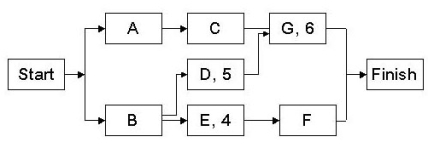Essay
Use the following network diagram and table to answer parts (a) through (d).

(a) Under "normal" conditions: what is the earliest the project can be completed; what is the critical path; what is the cost?
(b) Suppose you wanted to complete the project one week earlier than under normal conditions. What activity(ies) would you have to speed up. How much would it add to the cost of the project?
(c) Under "crash" conditions: what is the earliest the project can be completed; what is the minimum it will cost to complete it in this time.
(d) The costs in part (a) through (d) are direct costs. Suppose overhead costs are determined by the formula C = 4000 + 2000t, where t is the project duration in weeks. Using this formula, what are the total project costs (direct plus indirect) for the project durations you got in parts (a) and (d)? Based on a cost comparison, should the project be completed under normal conditions, crash conditions, or somewhere in between?
Correct Answer:

Verified
Correct Answer:
Verified
Q13: An approach to accelerate a project by
Q14: Statement: Indirect costs include administrative, overhead, and
Q15: Which statement is correct. The critical chain
Q16: The Following Questions adapted from tutorial
Q17: Statement: PERT requires three time estimates for
Q19: Statement: A "resource loading" chart shows the
Q20: Which statement is correct: In the CPM,
Q21: Statement: In PERT, the mean (expected) time
Q22: Contingencies should be built in at the
Q23: If the project completion has a distribution